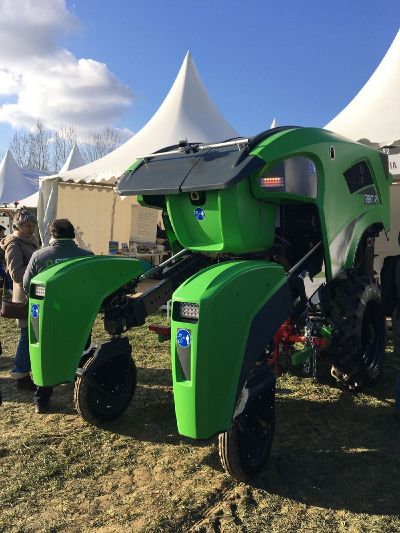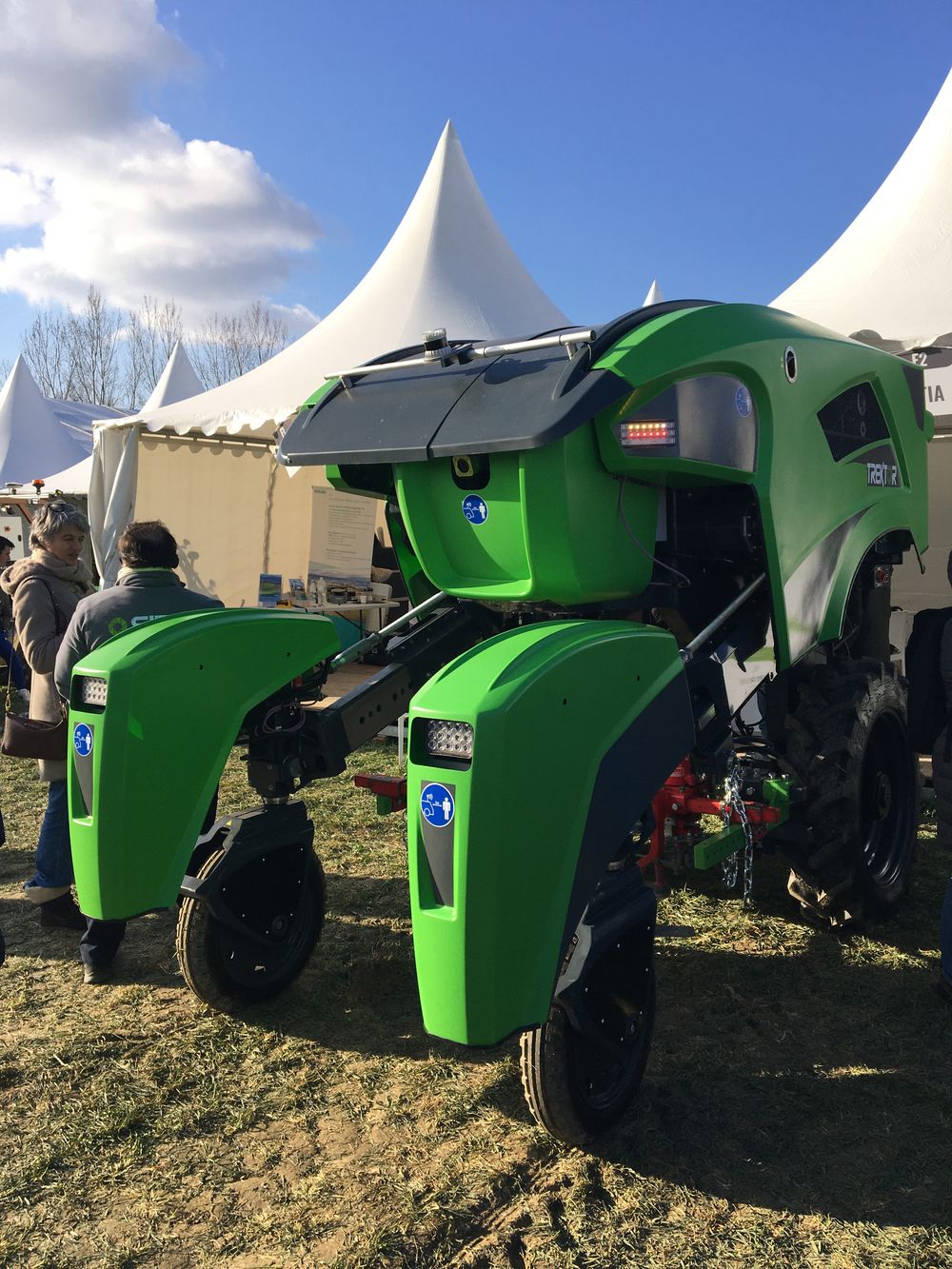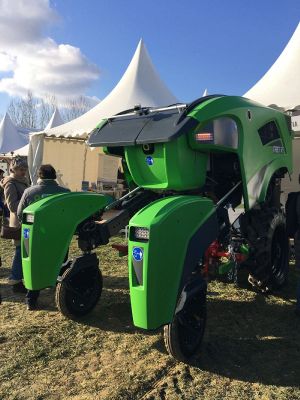Weeding robot
 Weed management using robots (weeding robots, targeted spraying, etc.)
Weed management using robots (weeding robots, targeted spraying, etc.)


A weeding robot is used to maintain a plot of land using a variety of weed control techniques (tillage, laser spraying, etc.). They come in a variety of sizes, motorisation, autonomy, etc...
Some 100% electric models also have a benefit in terms of CO2 emissions, as well as soil compaction in the case of the lightest models.[1][2].
However, robots are still expensive machines that are complex to operate and may not be suitable for all situations. [3][4][5].
What weed control tools are available?
Mechanical weeding
Most weed control robots are equipped with mechanical tools adapted to their size and speed, including hoeing machines, rotary tines, dethatchers and intercep for vineyards, and mowers for inter-rows and grassy headlands.
Users will be able to set parameters such as tool inclination, furrow depth and cutting height via an app on their smartphone or computer.
One of the disadvantages of robots with integrated tools is that farmers cannot repair them themselves, and are therefore dependent on the manufacturer. This is why a number of independent start-ups have designed their own robots with three-point linkages, to give farmers more autonomy. [6][7][8][9].
Chemical weeding
For greater efficiency, it is possible to purchase robots capable of spraying weeds with great precision. [10][11].
For certain crops, there are also robots that can be attached to sprayers [6][12].
According to manufacturers, robots with integrated sprayers can save more than 95 % on chemical inputs, although no technical institute has confirmed this promise.[10].
Laser weeding
In order to reduce the use of herbicides and tillage as much as possible, companies such as Pixel Farming are marketing robots that burn young weed shoots using a laser[13].
Other types of weed control
Other types of weed control are currently being tested by the main manufacturers, including :
- electric weed control
- thermal weed control
- weed control using UV light flashes
Electric, rechargeable and diesel robots
To date, robots are marketed and categorised in three different power supply modes :
Solar power
Several robots are equipped with solar panels. These robots, equipped with batteries, have the advantage of virtually unlimited autonomy[10] [14][15].
The Avo and Stecomat models, for example, switch off after dark once their batteries have been discharged, and resume work at dawn.[14] [10].
Rechargeable electric robots
Some robots run on lithium batteries with a range of between 8 and 12 hours. However, the main drawback is the need to recharge these batteries, which can be complex. The Toutilo robot from Touti terre is designed so that the battery can be removed and replaced.[16].
Diesel and hybrid engines
More and more models are being fitted with hybrid engines to adapt to irregular or sloping terrain. The advantages of the two power sources are combined at : the silence and cleanliness of the electric motor (particularly useful for plots close to rivers and streams) and the power of the diesel engine.
Safety
What happens when a robot hits an obstacle ?
All autonomous weeding robots are programmed to stop at the slightest obstacle it detects, whether fixed (a wall, a vine, etc.) or moving (a human, an animal, etc.).
This stop is made possible by several pieces of equipment :
- A "LIDAR" radar system : a system that can view the environment 360°, this is the case with Softirover from Softiver, the Ceol caterpillar and soon the new generation of robots from Farmdroïd[17][18].
- A safety cable : this is the case with Farmdroïd's FD-20 model, where the robot stops immediately after a simple press on the cable surrounding the robot.[14].
- Bumpers : These are mechanical sensors protected by a layer of foam that stop the robot at the slightest pressure. Naïo technologies robots are all equipped with bumpers.
How does the robot find its way around the plot ?
All the autonomous weeding robots on the market are equipped with an RTK GPS guidance system, which gives them a high degree of tracking accuracy (between 1 and 2 cm).
RTK GPS navigation is often coupled with a "geofencing" system, enabling the virtual boundaries of the plot to be recorded, which will prevent the robot from going out and falling into a ditch, for example.
Geofencing can also be replaced by a physical breadcrumb trail connected to the robot's sensors, which can be moved around, as is the case with Softiver's Softirover robot.
The use of tools on the row is made possible by calculating the distance between rows and between cultivated plants, which must be done beforehand or by the robot on its first pass.
Is it necessary to monitor the robot ?
Once the robot has been programmed, it is no longer necessary to monitor it.
However, some models are subject to regulations requiring users to stay within a 200 m radius of the robot.[5].
Most robots are also unable to change plot on their own, and need to be transported between each plot. The difficulty of transport will depend on the size of the robot (and whether it can be towed).
Training
Getting to grips with the machine (especially its user interface) is essential if the robot is to be successfully integrated into crop management.
There are two possible scenarios :
- Manufacturers may offer training lasting between an hour and half a day. In this case, the robots are relatively simple to use and are often accompanied by an application that can be downloaded onto a smartphone or computer for easy access to all the functions.
- Manufacturers offer services and supervise the programming and operation of the robots themselves. This ensures that farmers can work more efficiently and save time, but in return they have to pay a subscription fee.
For what types of production ?
As crop protection is one of the pillars of agronomy, all types of agricultural production are targeted by robot manufacturers. However, in view of market demand, the range of models and functions varies from one sector to another.
Viticulture
The wine-growing sector is the one with the widest choice of robotics. Manufacturers are prioritising this sector in response to the shortage of seasonal workers.
Most of the models on offer are single-task or multi-function straddling robots with tools for working the inter-row and inter-cep. [19]. or high-precision sprayers[4]. Vitibot and Naïo technologies are the main suppliers of high-clearance robots, and all their robots have been tested by farmers[20].
The choice of straddling robot must be carefully considered in relation to the height of the vines and the distances between rows.[4]. However, smaller, more versatile robots also exist for working between rows[6]The Vitirover, for example, can be hired to mow inter-rows precisely without the risk of compacting. [15].
Market gardening and horticulture
Market gardening and horticulture do not lend themselves well to the use of agricultural machinery, but there are many market gardening robots. Vegetable-growing weeding robots are characterised by their low soil compaction, their diversity of weeding methods (mechanical, chemical or laser) and their multifunctionality.
The average market gardening robot can weed, monitor weed pressure, transport equipment and sow.
The main market-gardening robots for sale can be used to :
- Make up for the difficulty of finding seasonal workers
- Prevent the spread of weeds by making several passes [3]
They also have their own limitations :
- Weed management requires the robot to know the exact position of each seed/plant. Sowing must therefore be adapted to the robot's dimensions, or even carried out by the robot itself.[3][14].
- Small robots such as Oz from Naïo technologies can be sensitive to bad weather. [3].
Arable farming
Globally, we will find tool carriers and autonomous tractors with or without a driver's cab for cereal production.[22][8][23].
The extent to which a robot can be adapted to arable farming depends on the power of its engine, its towing capacity and the implement to be towed.
Arboriculture
The arboriculture sector, which is relatively similar to winegrowing, is approached by the same manufacturers. However, the diversity of shapes and row heights makes this adaptation complex.
For inter-row weeding, robots fitted with a three-point linkage are preferred, such as the Trektor hybrid robot from Sitia or the Jo and Romax viti[8][24][2].
Advantages and limitations
Works day and night
Solar-powered electric robots can work for several days in a row, day and night, thanks to their long-life lithium batteries. If a robot breaks down due to lack of light, it can pick up where it left off a few hours after daylight (or good weather) returns.[14][10].
Precision
RTK GPS guidance enables real-time trajectory correction, guaranteeing precise weed control.[3][7][15].
Effective as part of a prevention strategy
Weed-killing robots are effective on juvenile stages of weeds. Robots that carry out mechanical weeding can pass over the inter-rows several times in a row.[3].
Reduced carbon emissions
Emissions per hectare from robots on the market are less than half those of conventional tractors (hybrid robots) or zero (solar-powered robots). [15][14].
Beware, however, that emissions from the manufacture of batteries are significant. A full calculation is therefore needed to establish the relevance of using these robots as an alternative to other options when it comes to assessing their environmental impact.
Few choices in arable farming and arboriculture
This is due to the wide diversity of soil and climate conditions and the specific characteristics of each crop species.
However, prototypes are currently being developed.
Designed for a specific context
One of the challenges of the robotics industry is to be able to adapt a robot to new situations, which is difficult to programme.
You need to find out from the manufacturers and a technical adviser what the limiting factors are (climate, soil type, row spacing, crops, weed stage).
Regulations
The regulations for certain models require the permanent presence of an operator in the vicinity. It is important to check with your dealer what the current regulations are before buying a weeding robot.[5].
A strong commitment to the manufacturer's system
The farmer's level of dependence on the manufacturer depends on the level of integration of the robot :
- Paid training in the use of the robot
- Purchase of parts and tools compatible with the robot
- Repairs only available from manufacturers
- Chargeable geofencing services
- Complex robot programming requiring the expertise of a technician
- Monitoring of robot operation by a technician
- Collection of plot data by the manufacturer to improve the robot programme
Financial aid
Since April 2022, France AgriMer has launched national aid open to all farms to encourage them to invest in digital farming. The ceiling on eligible expenditure is set at €40 ,000 excluding VAT per application.
For CUMAs, the ceiling on eligible expenditure is set at €150,000 excluding VAT per application.
The rate of aid for robots is set at 40 of the cost excluding VAT. Young farmers and farms in the French overseas departments benefit from additional aid[25].
Sources
All the analyses in this article can be found on Corentin Leroux's "Aspexit" blog :
- ↑ Naïo technologies.2022.Technical specifications. (07/02/2023) https://www.naio-technologies.com/oz/
- ↑ 2.0 2.1 Vitisphere.2021.The Romax Viti vineyard robot works the soil. (07/02/2023) https://www.youtube.com/watch?v=8H0QLni7I9A
- ↑ 3.0 3.1 3.2 3.3 3.4 3.5 Poudevigne Elise - Entraid'.2021.Oz: the market garden weeding robot on trial. (27/01/2023) https://www.entraid.com/articles/demonstration-robot-desherbage-oz-sud-ouest
- ↑ 4.0 4.1 4.2 Abellan Alexandre - Vitisphere.2019.Bakus robot demonstrates vineyard expectations. (31/02/2023) https://www.vitisphere.com/actualite-90067-le-robot-bakus-fait-la-demonstration-des-attentes-du-vignoble.html
- ↑ 5.0 5.1 5.2 Chambrin Anthony - Fédération des CUMA Centre Val de Loir.2021.Bakus robot : more economical than a straddle tractor with driver ? (31/01/2023) https://www.entraid.com/articles/rentabilite-robot-bakus-vitibot-comparatif-enjambeur
- ↑ 6.0 6.1 6.2 Favre Séverine - Mon Viti.2021.The Romax Viti robot is making headway. (25/01/2023) https://romaxviti.com/wp-content/uploads/2021/02/romax-article-viti-fevrier-2021.pdf
- ↑ 7.0 7.1 Vitisphere.2021.The Romax Viti vineyard robot works the soil (25/01/2023) https://www.youtube.com/watch?v=8H0QLni7I9A
- ↑ 8.0 8.1 8.2 Tiers Nathalie - Ouest-France.2022.Trektor, the agricultural robot made in Nantes. (29/01/2023) https://www.ouest-france.fr/economie/agriculture/essais-agricoles/trektor-le-robot-agricole-fabrique-a-nantes-65d4b832-b753-11ec-91b4-4cb12076d3f2
- ↑ Le Sillon belge.2020.Dino, Oz, Anatis and Toutilo: your new farm workers under the microscope. (03/02/2023) https://www.sillonbelge.be/6539/article/2020-09-23/dino-oz-anatis-et-toutilo-vos-nouveaux-ouvriers-agricoles-sous-la-loupe
- ↑ 10.0 10.1 10.2 10.3 10.4 Ecorobotix. SA2020.AVO - Autonomous weeding robot - presentation film - Court FR. (29/01/2023) https://www.youtube.com/watch?v=uNTLt-XQNEk
- ↑ Groult Aurélien - Agricultural equipment. 2022. Ecorobotix : the ARA weeding robot adapts to the rear of the tractor.
(27/01/2023)
https://www.materielagricole.info/robot-de-desherbage/article/729635/ecorobotix-le-robot-de-desherbage-ara-sadapte-a-larriere-du-tracteur
- ↑ Bordeaux Pascal.2021.Tomorrow's spraying : the sprayer sees weeds and a robot pulls it. (23/01/2023) https://www.entraid.com/articles/desherbage-autonome-goldacres-robot-swarm-pulve-bilberry
- ↑ Pixelfarmingrobotics.2023.Robot One. (17/02/2023) https://pixelfarmingrobotics.com/robot-one/
- ↑ 14.0 14.1 14.2 14.3 14.4 14.5 Stecomat.2020.FarmDroid FD20 : the first autonomous robot for seeding and full mechanical weeding. (23/01/2023) https://www.youtube.com/watch?v=9DMlGP6WHAI
- ↑ 15.0 15.1 15.2 15.3 Rolin Faustine.2022.Vitirover, robots that prevent weeds from growing on crops.
(23/01/2023)
https://leshorizons.net/vitirover-robots-perserver-enherbement-cultures/
- ↑ 16.0 16.1 Touti terre.2022.Cobot Toutilo.
(26/01/2023)
https://www.toutilo.com/
- ↑ Portier Michel - Réussir Grandes cultures.2023.Les 10 robots agricoles que ne fallait pas manquer sur le World Fira. (17/02/2023) https://scontent-cdg2-1.xx.fbcdn.net/v/t39.30808-6/330802631_1617007642046239_4532546166957931973_n.jpg?_nc_cat=100&ccb=1-7&_nc_sid=730e14&_nc_ohc=5gXTgbI6Wz4AX_fnu-H&_nc_ht=scontent-cdg2-1.xx&oh=00_AfDPRZcWFgq-gzZmw94EQwJZ8mYiyxZJSHwY3EU9rEWXxg&oe=63F40679
- ↑ Agreenculture.2023.Ceol, autonomous agricultural robot. (17/02/2023) https://www.agreenculture.net/ceol
- ↑ FMV Defrance and Naïo technologies.2017.BOB vineyard weeding robot. (20/01/2023) https://www.youtube.com/watch?v=MjdJM8ADZIc
- ↑ Official Vitibot website. (26/01/2023) https://vitibot.fr/robots-viticoles-bakus/
- ↑ Hauts-de-France Chamber of Agriculture.2022.Robotics at the service of market gardening.
(26/01/2023)
https://hautsdefrance.chambre-agriculture.fr/articles/detail-de-lactualite/actualites/la-robotique-au-service-du-maraichage/
- ↑ Chambre d'Agriculture de Normandie.2020.Robots in arable farming. (29/01/2023) https://normandie.chambres-agriculture.fr/fileadmin/user_upload/Normandie/506_Fichiers-communs/PDF/PEP/pep-gc-robots.pdf
- ↑ Naïo technologies.2023.Orio, tool carrier for vegetable and field crops. (17/02/2023) https://www.naio-technologies.com/orio/
- ↑ Naïo technologies.2023.Jo self-contained crawler narrow vines and nurseries. (17/02/2023) https://www.naio-technologies.com/jo/
- ↑ FranceAgrimer.2022.France 2030 - Wave 1 - Reduction in phytopharmaceutical inputs and synthetic fertilisers. (01/02/2023) https://www.franceagrimer.fr/Accompagner/France-2030-Souverainete-alimentaire-et-transition-agroecologique/France-2030-Agriculteurs/France-2030-Vague-1-Reduction-des-intrants-phytopharmaceutiques-et-des-engrais-de-synthese